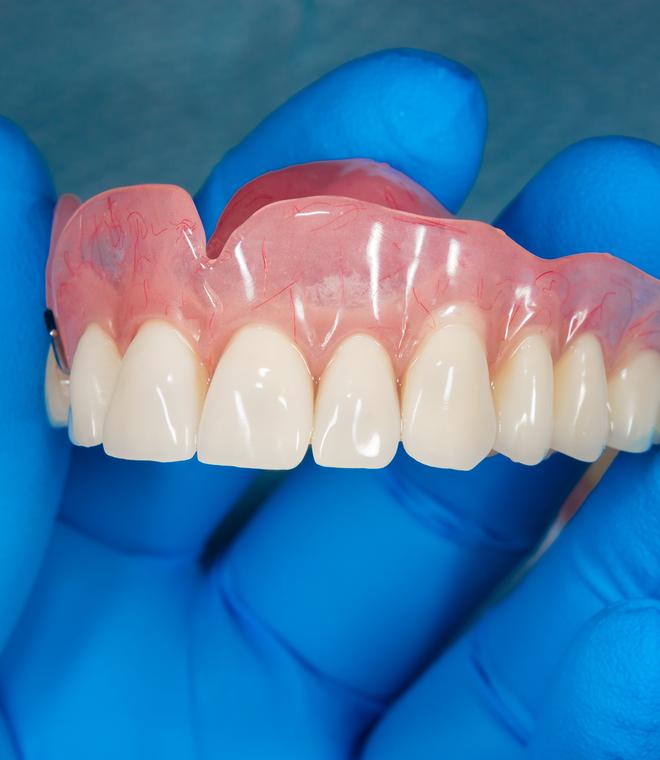Dentures can be fixed or removable, partial or full, and implant supported or not.
A denture replaces multiple missing teeth. Fixed dentures (also known as bridges) require implants, while removable dentures may or may not use dental implants for attachment.
Traditional Dentures
Full Dentures for Edentulous Patients:
(Missing All Teeth in Either the Upper or Lower Arch)
Traditional dentures are removable, and do not use implants. Traditional dentures include an acrylic base that is custom-made in the dental laboratory to mimic the appearance of natural gums, and this base sits over the gums, holding the denture in place. A complete (full) denture is made after all the teeth in the upper and/or lower jaw have been removed and the gum tissue has healed.

Patients with no natural teeth left must use a prosthetic device (denture) that is designed to replace their natural teeth. Historically, removable dentures were all dentistry could offer patients in these situations, but they were far from ideal solutions. There was often less than optimal function (bite), continual gradual shrinkage of the upper and/or lower jaws and an increased fragility of the remaining jawbone. Esthetically, the bone resorption displays a visibly recessed jaw line that becomes increasingly evident when the dentures are removed.
Denture paste or adhesive is often to used to help hold the denture in place. Removable dentures can be regularly removed and cleaned when not being worn.
Despite the drawbacks of this treatment option and our recommendation to work with implant supported dentures whenever possible, there are certain situations where removable dentures are the only alternative.
Partial Dentures
Partial Dentures for the Patient Missing Several Teeth in One Arch:
A traditional partial denture is a removable solution for replacing many teeth in one arch when there are still some natural teeth present. In this case, the acrylic base will also contain some metal attachments that wrap around the existing teeth for added support. Partial dentures can also be attached to crowns on either side of the denture.

The removable solution has many disadvantages over the fixed alternatives.
The most important ones are function and comfort. A removable partial denture will not have the support and stability to permit completely “normal” biting function. Also, the area without natural teeth will continue to experience gradual bone resorption.
In addition, taking care of your partial dentures may require more than simple cleaning. If not carefully cared for, it might lose its proper shape, as they are very fragile. If they get damaged at all, it is best to consult us, as damaged partial dentures may cause irritation and sores. If your partial dentures no longer fit properly, breaks, cracks or become loose, we will help you make the necessary adjustments so that you are comfortable.
Removable partial dentures may be removed and cleaned when not being worn.
Implant Supported Dentures
Implant supported dentures may be either fixed or removable.
This technique offers several advantages over traditional dentures.
Patients with no teeth (edentulous) typically needed to resort to the use of complete dentures. Traditional removable dentures were usually not very efficient functionally (i.e. presented difficulties with biting and chewing some foods) and their use frequently resulted in continued resorption of the lower and upper jaw bones. Resorption may in turn lead to greater fragility of the jaw bone itself.

Implant supported dentures take care of all of these issues. Firstly, the use of implants significantly improves the overall function of the prosthesis, bringing it closer to the “performance” of natural teeth. This allows patients to resume normal, or very close to normal eating habits. Secondly, dental implants also act as “natural” roots and therefore prevent any long-term resorption of the jaw bone.
Implants can be used to anchor dentures in place, allowing for a smaller base and less shifting of the prosthesis during use. Implants can support both full and partial dentures as well as both fixed and removable dentures.
In this solution, two or more implants are placed. If a removable denture is chosen, the denture will attach to the implant with a snap rather than requiring the use of denture paste or adhesives. Removable dentures may be taken out for cleaning at night.
This solution may simulate the look and feel of natural teeth, is easy to care for and stays fixed in place with the implants acting as anchors. Patients will not experience the typical shifting and movement or gum irritation often experienced with dentures.
Dental implant placement may also help alleviate the sunken look that may happen with bone loss in the jaw by creating bone growth in the area around the implant. This process is known as osseointegration and may also help prevent future bone loss.
 Skip site navigation
Skip site navigation
